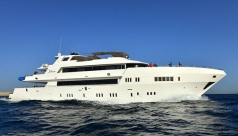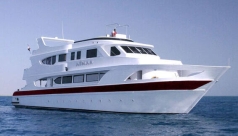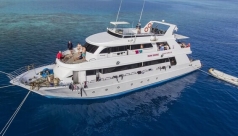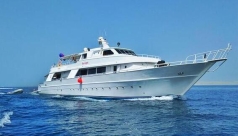Home Reefs & Parks
A History of the Formation of the Red Sea Why Egypt's Famous Dive Destination has High Levels of Endemism
The Red Sea is a rather narrow trench of water, running northwest to south easterly, approximately 2,000 km long and 2,000m deep, formed some 38 million years ago.
It has a remarkably high number of endemic (that is, live exclusively in the region) fish and invertebrate marine species, thought to be in the region of 20% of species living here. This is one of the main attractions to scuba dive in the Red Sea since you can only ever see these fish species by visiting here.
Roughly, 5 million years ago only the northern end was connected to the Mediterranean Sea. As the land slowly uplifted, the Mediterranean connection closed and the Red Sea basin became a great evaporation pan, forming thick salt levels which later would raise the sea's salinity levels.
Some time later its southern end at the Strait of Perim finally opened, making it the northwest appendix to the Indian Ocean. Water filled the trough, bringing with it fish species from the Indo-Pacific. However, due to the narrow and shallow nature of its mouth, the Red Sea is partially isolated and has a mean temperature and salinity higher than the adjacent Indian Ocean.
What's more, during the later ice ages as little as 15,000 years ago, so much water was locked up in polar ice that water levels fell over 100m from its current level. This would have cut off the newly formed Red Sea from the Indian Ocean once more.
These conditions then triggered the evolutionary processes that resulted in the high numbers of endemic species that you'll find when diving in the Red Sea and nearby Gulf of Aden, often with closely related counterparts in the nearby Indian Ocean.
Naturally, endemic species will be reef inhabitants and not pelagic fish, so it is perhaps no surprise that the highest levels of endemism are found in species such as the dottybacks, triplefin blennies and butterflyfish, half of which are endemic.
The Red Sea only reached its current level 5,000 years ago so its coral reefs are still relatively young. The southern end at the Strait of Perim is also known as Bab El Mandeb (meaning "Gate of Lamentations"). It is 29 km wide at this point and only 130m deep, making it the narrowest and shallowest part of the sea. Indeed, Somali folklore even has it that their ancestors crossed over these straits from Arabia.
Click to view product. Special discounted trips highlighted in yellow
Blue
Customer rating: Excellent!
Visits Red Sea North and South
Spacious bright cabins with priv... Rebreather facilities
Large boat
Ghazala Explorer
Customer rating: Excellent!
Liveaboard cruises throughout th... Spacious cabins with private bat... 3 dive guides per full charter
All-inclusive pricing policy
Modern and large steel hull moto...
Golden Dolphin I
Customer rating: Excellent!
Operates trips throughout the Re... All cabins have ensuite bathroom... Spacious air-conditioned saloon
2 week safaris available
Golden Dolphin IV
Customer rating: Excellent!
Visits Red Sea North and South
All cabins with private bathroom... Dedicated restaurant room with b... Large boat
Red Sea Aggressor II
Customer rating: Excellent!
Visits Northern Red Sea
All cabins with private bathroom... Free local wine and beer, lost d... Photo/video center
Sun deck with Jacuzzi
Large boat with steel hull
Royal Evolution
Customer rating: Excellent!
Unique Red Sea and Sudan diving ... All cabins with ensuite bathroom... In-cabin morning coffee/tea serv... 4 decks, sun deck with hot tub a... 10, 12 and 15 litre tanks, nitro... Large steel hull boat
Sea Serpent Glorious Miss Nouran
Customer rating: Excellent!
Cruises Red Sea South
Trip prices inclusive of port an... All cabins with private bathroom... Dedicated indoor restaurant with... Large boat
Serenity
Customer rating: Excellent!
Liveaboard cruises throughout th... Cabins with private bathrooms
Upper deck seaview cabins
All-inclusive pricing policy
Managed by PADI 5-Star IDC Cente...
Snefro Pearl
Customer rating: Excellent!
Specialises in short diving crui... Sharm El Sheikh liveaboard
Visits Ras Mohamed and Thistlego... Cabins with private en-suite bat... Very small number of guests per ... Green Fins certified
Blue Seas
Customer rating: Very good!
Visits Red Sea South
All cabins with private bathroom... Huge Honeymoon Suite
Large boat
Emperor Elite
Customer rating: Very good!
Visits Red Sea North and South
No extras on top of the price
Winner of our 'Liveaboard of the... All cabins ensuite with media pl... Dedicated restaurant, free dinne... Large boat
Emperor Superior
Customer rating: Very good!
All-inclusive prices
Visits Red Sea North and South
All cabins with private bathroom... Dedicated restaurant
Large boat with many relaxation ...
Golden Dolphin II
Customer rating: Very good!
Visits Red Sea North and South
All cabins with private bathroom... Dedicated dining room with bar
12 and 15 litre tanks
Large boat with 2 sundecks
Golden Dolphin III
Customer rating: Very good!
Visits Red Sea North and South
All cabins with private bathroom... Dedicated restaurant room with b... Large boat
JP Marine
Customer rating: Very good!
Visits Red Sea North and South
Low budget dive cruises
Cabins with private bathrooms
Large boat
Red Sea Aggressor IV
Customer rating: Very good!
Visits Red Sea South
All cabins with private bathroom... Free local wine and beer
Sun deck with 2 hot tubs
Large modern boat
Sea Serpent
Customer rating: Very good!
Cruises Red Sea North and South
All cabins with private bathroom... Dedicated restaurant with bar
Helium/oxygen blending station
Safari prices inclusive of port ...
Sea Serpent Excellence
Customer rating: Very good!
Visits Red Sea North and South, ... Prices inclusive of port and par... All cabins with private bathroom... Dedicated restaurant with bar
Rebreather facility
Blue Force 2
Customer rating: Good
Liveaboard cruises from Sharm El... Sinai Peninsula diving tours
Cabins with private bathrooms
Outdoor upper deck sundowner bar
Blue Pearl
Customer rating: Good
Cruises Red Sea North and South
All cabins with private bathroom... Spacious comfortable communal ar... Large boat
Discovery I
Customer rating: Good
Liveaboard trips throughout the ... All cabins with private bathroom... Great value economy cruises
Upper deck sunset bar
Emperor Asmaa
Customer rating: Good
Visits Red sea North and South
All inclusive transparent prices... All cabins with private bathroom... Dive computers available
Computer for internet and photo ...
Heaven Saphir
Customer rating: Good
Cruises Red Sea South
All cabins with private bathroom... 3 sundecks & large shaded area
12 & 15 litre tanks available
Large boat
MY Blue Horizon
Customer rating: Good
Visits Red Sea North and South, ... Cabins with private bathrooms
Separate saloon and dining areas... Jacuzzi on sun deck
Rebreather friendly
Large yacht
MY Blue Melody
Customer rating: Good
Visits Red Sea North and South
All trips are confirmed departur... Cabins with private bathroom and... Dedicated dining area, 2 separat... Rebreather friendly
Large dive boat
Sea Serpent Grand
Customer rating: Good
Visits Red Sea North and South
All cabins with private ensuite ... Cruise price includes port and p... ENOS diver safety system onboard... Helium/oxygen blending station
Large boat
Sea Serpent Serena Dreams
Customer rating: Good
Visits Red Sea North and South
Trip price includes port and par... All cabins with private bathroom... Cruises for smaller groups
12 & 15 litre tanks available
Seawolf Dominator
Customer rating: Good
Visits Red Sea of Egypt and Suda... All cabins have private bathroom... Technical diving facilities
ENOS satellite location and resc... Large boat
South Moon
Customer rating: Good
Sinai Liveaboard cruises
Diving at Thistlegorm, Ras Moham... Dives conducted from Zodiacs
All cabins have private bathroom... Upper deck cabins available
Sunshine
Customer rating: Good
Liveaboard cruises in the northe... Dves conducted from Zodiacs and ... All cabins have private bathroom... Main deck cabins with sea views
Outdoor bar for sundowners
Sunlight
Customer rating: Average
Liveaboard cruises in Red Sea So... Dves conducted from Zodiacs and ... All cabins have private bathroom... Outdoor bar for sundowners
Blue Storm
Customer rating: Be first to rate!
Visits Red Sea North and South
Spacious bright cabins with priv... Dedicated restaurant
Rebreather friendly
Large steel hull boat
Discovery II
Customer rating: Be first to rate!
Liveaboard diving safaris across... All cabins with private bathroom... Great value economy cruises
Upper deck sunset bar
Large wooden hull motor yacht
Dolce Vita
Customer rating: Be first to rate!
Visits Red Sea North and South
All cabins with private bathroom... Sundeck Jacuzzi and massage tabl... Open Water Diver course availabl... Large boat
Dune Silky
Customer rating: Be first to rate!
Liveaboard trips throughout the ... Modern design
Large seaview cabins with privat... All cabins above the water
Inclusive price policy
Large steel hull motor yacht
Emperor Seven Seas
Customer rating: Be first to rate!
Visits Red Sea North and South
No extras on top of the price
All cabins ensuite with TV playe... Dedicated restaurant, free dinne... Large boat
Firebird
Customer rating: Be first to rate!
Dive cruises in the northern Red... Max. capacity of just 16
ENOS lost diver tracking
Rebreather friendly
All cabins with private bathroom... Special family cruises
Hammerhead II
Customer rating: Be first to rate!
Dive cruises throughout the Red ... All cabins with private bathroom... Master cabins with panoramic vie... Onboard Jacuzzi
Large and stable yacht
Modern steel hull
Lewini
Customer rating: Be first to rate!
Liveaboards throughout the Red S... Inclusive price policy
Spacious cabins with private bat... All cabins are well proportioned... Dolphin adventure cruise for fam... Modern and large motor yacht
MV Odyssey
Customer rating: Be first to rate!
Visits Red Sea North and South
All cabins with private bathroom... Sundeck Jacuzzi and massage tabl... Open Water Diver course availabl... Large boat
Sea Serpent Contessa
Customer rating: Be first to rate!
Visits Red Sea South
Cruise prices inclusive of port ... Cabins with private bathrooms
Dedicated restaurant
Large boat
Seawolf Steel
Customer rating: Be first to rate!
Visits Red Sea South
All cabins with private bathroom... Super-modern liveaboard
ENOS satellite location and resc... Large steel hull yacht
Snefro Love
Customer rating: Be first to rate!
Sharm El Sheikh luxury liveaboar... Dives at Thistlegorm, Ras Mohame... All cabins have private bathroom... Main deck Master Suite onboard
Green Fins certified
Large wooden yacht
Snefro Spirit
Customer rating: Be first to rate!
Sharm El Sheikh liveaboard dive ... Visits Ras Mohamed, Thistlegorm,... Cabins with private en-suite bat... Cabin to cabin comms system
Green Fins certified
Snefro Target
Customer rating: Be first to rate!
Luxury Sinai liveaboard boat
Dives at Thistlegorm, Tiran Stra... Main deck Master Suite onboard
All cabins have private bathroom... Green Fins certified
Large wooden hulled yacht
Thunderbird
Customer rating: Be first to rate!
Southern Red Sea liveaboard crui... ENOS lost diver tracking
Max. capacity of just 16
Special kids cruises
Rebreather friendly
All cabins with private bathroom...
Titan
Customer rating: Be first to rate!
Liveaboard trips across the Red ... Inclusive price policy
Large cabins with private bathro... All cabins are well proportioned... Huge saloon
Large wooden motor yacht
Click to view product. Special discounted trips highlighted in yellow
DIVE THE WORLD TESTIMONIAL
Pete Cairns South Africa
Quick responses to all my questions. I didn't need to worry about anything regarding my trip, all information was available and easily accessible. All top service



















































